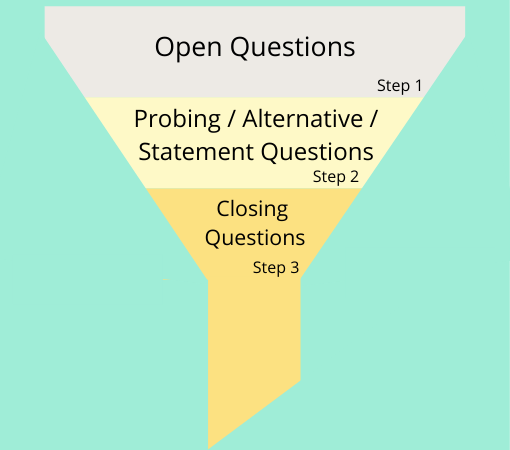Mastering call control is essential for contact centre advisors to handle both simple and complex customer interactions effectively.
Whether it’s active listening, empathy, or managing difficult conversations, the right skills and techniques can greatly improve service quality.
In this article, we’ll explore seven fundamental call control skills and provide tips to help advisors excel in each area.
7 Fundamental Call Control Skills and Techniques
No matter how difficult the call is to answer, it is important that advisors are coached to exhibit each of these fundamental skills and techniques.
1. Active Listening
Active listening goes beyond processing what a customer is saying. It is about understanding the tone and vocabulary that is being used as well.
“Listen to what the customer is not saying too and let them know that they are being listened to by interjecting with verbal nods that encourage an open conversation,” says Kim.
Doing all this at once is tricky, particularly as most of us listen to respond and share our thoughts, instead of getting to the bottom of what the other person is saying.
Yet, through active listening advisors can get to the real crux of the issue, open up an honest conversation and create trust with the customer.
Here are three key pointers to coach active listening in the contact centre:
- Ask advisors to guard against inhibitors to their listening, such as assumptions and distractions.
- Listen to call recordings. Talk to the team about the emotions they can detect so that advisors take this into account on their calls.
- Play games to improve active listening. One particularly common listening exercise is called “The Witches of Glum”, which is one to research further.
2. Empathy
Empathy enables advisors to create a connection with the customer. It also helps to establish that everyone is working together and is on the same side.
When you create this environment – where both parties can share their emotions, thoughts and feelings – the call is easier to control, as the customer respects what the advisor has to say.
“Classic techniques – such as ‘smile as you dial’, being mindful of your posture and developing self-awareness – will all help get the customer on your side,” adds Kim.
With this platform in place, you can coach advisors to demonstrate empath by:
- Using empathy statements appropriately, reflecting back the words that customers use, acknowledging their emotions and offering reassurance.
- Making it authentic. Ask leaders to remind advisors just how important these conversations are to customers and – as cheesy as it sounds – ask advisors to walk in their shoes.
- Roleplaying conversations in which high levels of empathy are essential, so advisors feel comfortable in managing these situations.
3. Knowledge
Active listening and empathy are the cornerstones of customer service. But they mean nothing unless the advisor can match the right customer up with the right solution.
Yes, now we’ve met the customer’s emotional needs, it is time to meet their functional needs – which is quite difficult for companies in which information about their products changes regularly.
Add to this the fact that automation and self-service are snapping up those simple, transactional calls, and it becomes clear that knowledge is a skill of growing importance within the industry.
Giving advisors the right tools to do their job and coaching are critical here. But there are also a few other ways of boosting advisor knowledge in the contact centre.
- Create ways for advisors to share best practices. Naming and training subject-matter experts who are in charge of sharing their knowledge is one example.
- Involve advisors in creating, reviewing and adding articles to the knowledge base to help plug gaps in advisor know-how.
- Analyse complaint volumes and create learning material – like webinars, lunch-and-learn sessions and online quizzes – to address these problem areas.
4. Match and Mirror
It’s great when an advisor can “flex” their call handling style, as not every customer will be interested in building rapport or talking about the weather. Some will just want to get the job done.
In most cases, it is important to show real empathy and compassion, but some customers just won’t be interested in playing that game.
So, when the advisor tries to make a connection with the customer and they don’t respond as hoped, don’t put pressure on the advisor to dig their heels in. The situation will only become worse.
Instead, it is good for advisors to read the mood, consider how they can match and mirror the customer’s mood and use similar words, expressions and tone.
Warning! Don’t follow this tip when the customer is aggressive. After all, if a customer starts shouting and swearing, advisors can hardly follow suit.
Find out how you can properly manage calls with aggressive customers by reading our article: Dealing With Angry Customers
5. Sidetrack Cautiously
In many conversations, it is easy to be sidetracked away from the topic at hand. This is often fine and can improve advisor–customer rapport, but sometimes advisors can talk about themselves for a long time and the customer will take that as an invitation for a long “pow-wow”.
But that is not controlling a call. That won’t help to streamline customer conversations.
So, while a small anecdote is nice, the advisor should try to steer the conversation back to the issue at hand. Asking a question is a great way to do this.
Set the question up with a phrase like: “So, you mentioned earlier…”, before the chat starts to go on for a couple of minutes (and potentially get awkward).
Even better, fill the gap with a quick bit of acknowledgement, using positive words to describe their story – such as “that’s excellent” or “great stuff” – before getting the call back on track.
6. Use the Customer’s Name (Appropriately!)
“When saying something really important to the customer, working their name into the sentence can be a great way to hook them in. Remember, people pay attention to their name,” says Kim.
Just don’t overuse it, otherwise it can come across as false. In fact, many would suggest working it in just at the beginning, middle and the end of the call.
Also, coach advisors to make sure that they get the customer’s name right. While it may sound obvious, this is easy to get wrong and some people can be very particular about this. This can undermine the advisor’s control of the call.
A classic example is with the name Naomi. Some will pronounce it “Nay-omi”, others will say “Nye-omi”.
So, when the customer introduces themselves, write their name down phonetically. Don’t just read it off the CRM system – especially if it is an unusual name.
For more information on how to address the customer appropriately, read our article: How Should We Address Callers?
7. Change Mindsets
Advisors are not robots, they have feelings and negative thoughts that impact daily performance and their call control.
Here are some examples of negative thoughts that often creep into an advisor’s mind, as shared with us by customer service expert Christine Knott. Just consider how powerful it would be if advisors could change their thinking to the alternative.
| Instead of Thinking | Change Your Mindset and Think: |
|---|---|
| “I don’t fell like smiling.” | “Smiling will start the rapport process and help me to serve the customer better and faster.” |
| “It’s nearly time to go home and this call has come through.” | “Let’s sit upright, smile and begin building rapport so I can service this customer nice and quickly, then I’ll be able to go home.” |
| “This customer sounds just like that difficult one that I had last week.” | “Maybe they do, but what other evidence do I have that they will be like that customer? None, so I’ll focus on them as an individual.” |
In order to change this thinking, the contact centre needs input from leaders and managers.
Ideally, they will be engaging in open conversations with advisors, being an enthusiastic presence and encouraging the team – whenever they have such a negative thought – to find the positive alternative.
How to Handle Different Types of Calls
Call Control Techniques for Simple Calls
Call control techniques in customer service is much simpler when the advisors feel as though the customer has confidence in them to solve their query.

“To capture this confidence, the advisor can tell the customer – at the start of the call – exactly what will happen, in the right order, so they know what to expect. This technique is also known as ‘signposting’,” says Kim Ellis, Chief Learning Architect at Go Ginger Learning.
Of course, this only works for those common types of queries that have a simple structure for advisors to follow. Nevertheless, it can really help the advisor to take ownership of the call so that customers feel that they are in a safe pair of hands.
Signpost
With signposting, advisors can also tell customers – at the start of the call – all of the information that they will need to resolve the matter. Whether it’s account number, pen and paper or debit card details, the customer will have everything that they need from the get-go, so the momentum of the call isn’t jeopardized.
Summarise
To further build this momentum, advisors can summarize what has been achieved at the end of each key step of the call, before reiterating where they are in the call handling process and moving on.
Streamline
By streamlining calls, this call control skill not only instils confidence but also cuts down on call handling times.
For more on how signposting can improve call control, read our article: Reduce Your Average Handling Time (AHT) by 15 Seconds
Call Control Techniques for Tricky Calls
For trickier calls, advisors will have to channel their inner Sherlock and ask questions to uncover specific information to resolve the query.
One great questioning method is the funnel technique. This is a three-step process, which is highlighted in the diagram below.

To start, ask broad open questions to gather important information. For example:
- How can I help you today?
- What are you looking for?
- What are your main concerns about the product/service?
These questions will help the advisor to understand the drivers behind the call – both emotional and functional – and show interest in everything that the customer has to say. Then, move down the funnel.

“Always follow up with a question to delve into some specifics. Use probing questions to home in on something particularly interesting, alternative questions to narrow down options or statement questions to confirm suspicions,” says Natalie Calvert, Founder of CX High Performance.
These questioning techniques are great for controlling a call, so let’s find out a little more about them:
Probing Questions
Probing questions encourage the customer to explore one specific area which they highlighted in answering the open question in more detail. TED questions are great for probing. This is where you start a question with the words: “Tell me”, “Explain”, and “Describe” (TED).
Example: “Describe to me how it looks?”
Alternative Questions
An alternative question presents the customer with two options or more. They then confirm which is true, helping the advisor to get closer to the heart of the issue.
Example: “Is the problem that you are experiencing new or is it a recurring issue?”
Statement Questions
These are statements with an intonation which signals a question. They are best used when an advisor thinks they know the answer and wishes to check if they’re right, as they start to build a solution for the customer’s issue.
Example: “This has happened before?”
Another great type of question to use in the contact centre is:
Assumptive Questions
An advisor may be confident that they understand the customer’s problem, but sometimes they need to double-check. Asking an assumptive question will do this, while provoking a response of agreement.
Example: “The delivery driver didn’t leave a note, did they?”
Finally, we get to the last stage of the filter. Now that the advisor understands the customer’s problem, reflect it back to them and ask a closed question to confirm mutual understanding. These closed questions elicit either a “yes” or “no” response.
An advisor could, for example, say:
- “Have I fully understood the problem?”
- “Have I missed anything important?”
- “Are we on the same page?”
You can then propose a solution and use another closed question to understand whether or not that fully resolves the query. An example would be: “Are you happy with our solution?”
Getting the customer to say “yes” to this closed question can be a powerful psychological tool to build enthusiasm around the solution.
But what if they say “no”? Coach advisors to go back to using open questions and work their way back down the filter.
Just make sure advisors don’t feel as though they have to rigidly stick to this method, as sometimes it will just make sense to follow an open question with a closed question. So don’t box them in!
If you want more examples of questioning techniques, read our article: 10 Effective Questioning and Probing Techniques for Customer Service
Are these four final tips not enough? Well, not to worry, there are many more insights about improving call control in the following awesome articles:
- Call Control Techniques: Controlling a Runaway Talker on the Phone
- Call Control Techniques: How to Present Options to Customers
- 20 Expert Ideas to Improve Your Customer Service Skills
Author: Charlie Mitchell
Reviewed by: Hannah Swankie
Published On: 28th Jul 2021 - Last modified: 15th Apr 2025
Read more about - Skills, Call Handling, Charlie Mitchell, Christine Knott, Editor's Picks, Empowering Agents, Kim Ellis, Natalie Calvert, Soft Skills

















